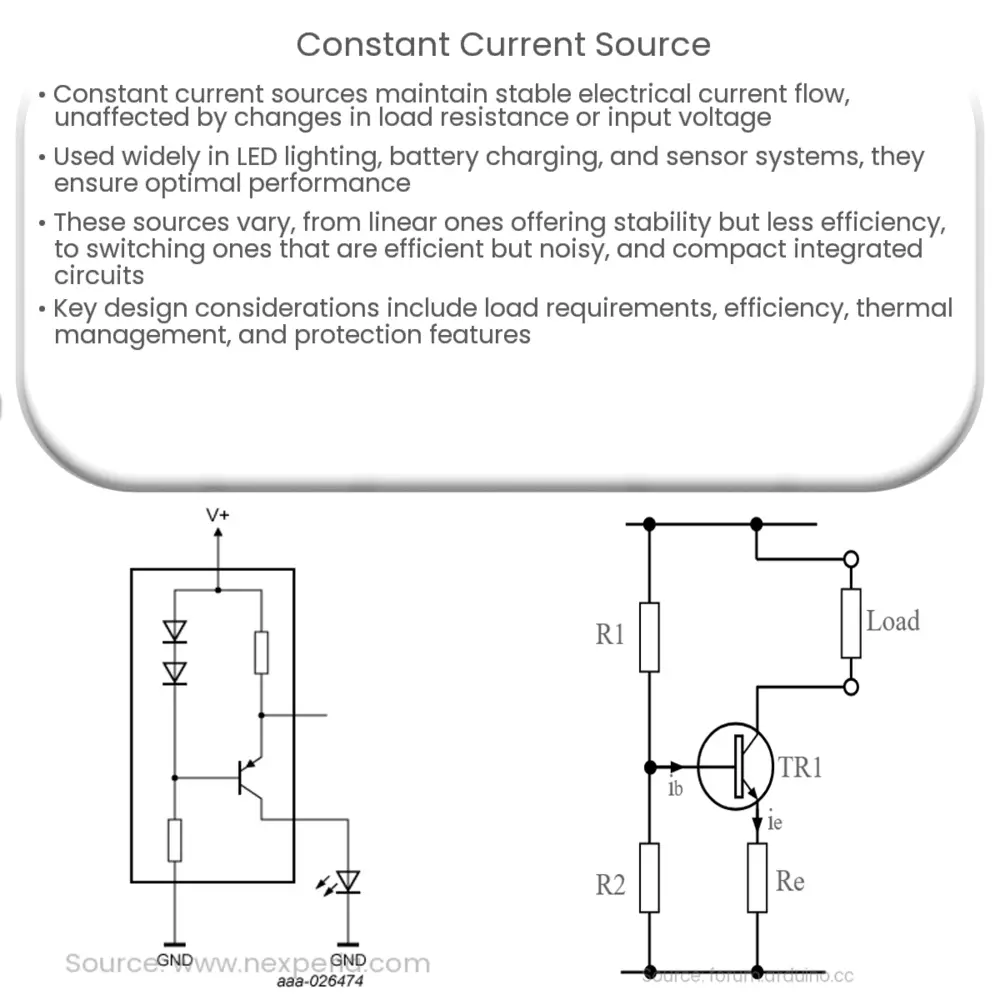A constant current source is an electronic component that maintains a stable current flow, regardless of load resistance or input voltage changes.

Constant Current Source: Understanding and Applications
A constant current source is a fundamental component in many electronic circuits, providing a stable and consistent flow of electrical current regardless of variations in load resistance or input voltage. This article aims to provide an overview of constant current sources, their working principles, and their applications in various electronic devices and systems.
What is a Constant Current Source?
A constant current source is an electronic circuit designed to deliver a consistent flow of electrical current to a load, independent of changes in the load’s resistance or the input voltage. This consistency is crucial in many applications, as it ensures that the performance of the connected device or system remains stable despite fluctuations in external conditions. A constant current source can be implemented using various components, such as transistors, operational amplifiers, and voltage regulators.
Working Principle of Constant Current Sources
The basic working principle of a constant current source is to use feedback mechanisms to maintain the current flowing through the load at a constant level, regardless of changes in load resistance or input voltage. This can be achieved by employing a transistor, operational amplifier, or a dedicated voltage regulator in the circuit. The constant current source circuit will adjust its output voltage to keep the current constant, thereby compensating for any changes in the load resistance or input voltage.
For instance, a simple constant current source circuit can be built using a single transistor and a resistor. The transistor acts as a variable resistor, with its resistance adjusted by the voltage applied to its base. The resistor sets the desired current level, and the transistor works to maintain that current through the load. When the load resistance changes, the transistor adjusts its resistance to compensate, keeping the current flowing through the load constant.
Applications of Constant Current Sources
Constant current sources find applications in various electronic systems and devices, including:
- LED lighting: LEDs require a constant current for optimal performance and longevity. A constant current source ensures that the LED’s brightness remains stable and prevents it from overheating, which can cause premature failure.
- Battery charging: Batteries require a specific charging current to optimize their charging process and prolong their lifespan. Constant current sources are used in battery chargers to provide a stable current during the charging process.
- Sensor applications: Sensors, such as temperature or pressure sensors, often require a stable current to ensure accurate and consistent measurements. A constant current source can provide the necessary stability for these sensors to function correctly.
In the second part of this article, we will delve deeper into the various types of constant current sources, their design considerations, and their role in specific applications. Stay tuned for more information on this essential electronic component.
Types of Constant Current Sources
There are several types of constant current sources, each with its unique characteristics and applications. Some common types include:
- Linear Constant Current Sources: These sources use a linear regulator, such as a transistor or operational amplifier, to maintain a constant output current. They offer excellent stability and low noise but can be less efficient, as excess energy is dissipated as heat.
- Switching Constant Current Sources: These sources employ switching regulators, like buck or boost converters, to maintain constant output current. They are more efficient than linear sources but can generate more noise and require additional components, such as inductors and capacitors.
- Integrated Constant Current Sources: These sources are designed as single integrated circuits that provide constant current output. They offer ease of use and can be more compact, making them ideal for applications with limited space, such as LED lighting or portable devices.
Design Considerations for Constant Current Sources
When designing a constant current source, several factors must be considered to ensure optimal performance and reliability. Some key design considerations include:
- Load Requirements: The required current and voltage range of the load must be considered to select an appropriate constant current source. This information is essential for determining the proper components and circuit topology.
- Efficiency: The efficiency of the constant current source is crucial, as it impacts the overall performance and power consumption of the system. Switching constant current sources generally offer better efficiency but may generate more noise, while linear sources are less efficient but provide better stability and lower noise.
- Thermal Management: Heat dissipation is a critical factor in constant current source design, as excessive heat can cause component failure or degrade performance. Adequate cooling, such as heat sinks or airflow, should be considered in the design process.
- Protection Features: Constant current sources should include protection features, such as overcurrent, short-circuit, and thermal protection, to safeguard the circuit and connected devices from damage.
Conclusion
Constant current sources are an essential component in various electronic systems and devices, providing a stable and consistent flow of electrical current to maintain optimal performance. By understanding the working principles, types, and design considerations of constant current sources, engineers and designers can develop robust and efficient electronic circuits to meet the specific requirements of diverse applications, such as LED lighting, battery charging, and sensor systems. With advancements in technology and the increasing demand for energy-efficient solutions, constant current sources will continue to play a crucial role in the development of modern electronic systems.

